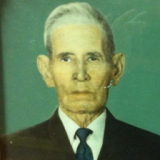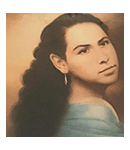Papa Kiko and Mama Chata’s Love Story
One gorgeous Fall day, Paula and her BFF Amalia sit under lush magnolia trees that adorn the picturesque and magical city of Cd. Mier, Tamps. Doing what BFFs do. Chatting away and sipping some tamarindo juice, they exchange “crushes” and talk about “exes,” but mostly Amalia listens to Paula talk about Argimiro, who has gotten quite serious with her. The courtship has not been long, yet Amalia knows that her BFF means business this time since Paula is usually a quiet, reserved young woman.
“So Amalia, what should I do about Argimiro, who’s asked me to marry him after only six months of dating?” “As you know, my sister Felicitas lives in McAllen, and I want to be with her, but I really really like Kiko, so I am confused.”
“Ay ay Paula, the hardest distance to travel is between your head and your heart; remember, we read that just this Sunday in the Book of James,” she recalls.
“Yes, I know, but I’m torn because I love my sister, and I feel as if I need to be close to her and help out my parents more financially,” Paula responds hastily, knowing that only she can make that decision.
Often, we make hasty decisions about our lives, but Paula was not one to act without thinking things through. She knew what her ancestors before she had endured, and she wanted to make sure she would do the right thing. That night, she sought the advice of her mother, Maria Ladislada, who told her to forget about her head for once and follow her heart.
“Tu corazon sabe mija, sigue esos latidos que oyes y sientes!” she told Paula.
“Mija, in the 1600’s there were many Spaniards in this country, nearly all men and our women were not as free to marry whomever they wanted. Sometimes, they were taken by force, and the fairer their skin, the more likely they would be taken as their wives.”
Maria Ladislada (1855-1900) told her daughter that while growing up, she had heard stories of how Mexico had already seen its share of turmoil and the “Conquista” from the Spaniards. Recalling what her family had told her, she reminds Paula of the dangerous times on the frontier then. There were savage Indians, others more civilized, and the friendly ones traded with the Spaniards. It was a time when the Crown endeavored to “civilize the Indigenous peoples of the land wherein a landowner is given the governance of Indigenous people and the right to their labor in return for taking on the sacred responsibility of bringing them into the Catholic faith.” (p.50, The Enlightenment of Juan Bautista)
“Yes, we have some Indigena blood, yet we are proud women who love God, and the caste system that was in place then (to no fault of ours) is slowly fading. I heard that Argimiro comes from “sangre azul,” mija. There is Jewish blood running through his veins. Still, you also come from great men like Captain Francisco Baez-de-Benavides-Lopez. He was born in 1594 in La Orotava, Santa Cruz de Teneferie, Canary Islands, Spain.
He discovered the mines of Salinas and San Nicolas de Tolentino in New Spain. In 1624, he held the post of Chief Constable of Monterrey. In 1626, he was alderman, and a year later, he had the position of councilman and procurator of Monterrey. In 1664, at 53 years of age, he was appointed mayor of Salinas, Victoria, by Governor Martin de Zavala.
Then there was Capitan Diego Gonzalez de Ochoa Elizalde (1653-1728), the legitimate son of Sergeant Major Diego González and María de Ochoa, residents of San Juan Bautista de Cadereyta. From an early age, he served the Crown as a sergeant, ensign, and assistant sergeant major. In 1675, he was appointed captain of infantry of the town of San Juan Bautista de Cadereyta. On several occasions, he held the alderman position in the Metropolitan City of Nuestra Señora de Monterrey.
And may you not forget that your GG Salvador Vela-Olivarez in 1767, received from the King of Spain, the land grants of Porcion 90 (6,248 acres) which was later on passed down to our founding fathers, so never forget that you CAN and WILL make the right choice and feel any inferiority in doing so. And the list goes on and on….so don’t let anything hinder your happiness, Mija!”
Paula had often wondered what that time might’ve been like, the early years more than 250 years before her birth. In school, she was taught that the Spaniards wanted dominance over the New Spain they had settled in. “The Spaniards, so precariously perched on top of this fluid and diverse mass of humanity, went to great extremes to hold this babel at bay, even though with each generation, their families became more intimately entangled with the polyglot population of this new continent.” (p. 36 The Enlightment of Juan Bautista ).
What would her ancestors say about this strange caste system put in place years before? Paula loved history and voraciously read anything she could find about the “blue Mediterranean [Sea] which brought many strange faces: Genoa-Greek and Savoyard, Moroccan, Sicilian, Levantine and Crimean. However, could anybody imagine this New Spain, vaster than the ancient Roman Empire, or creatures as alien as these Indians who worshipped the sun and the flesh of men? (p. 39 The Enlightenment of Juan Bautista)
Argimiro and Paula were as different as night and day. Kiko had noble and kind instincts, and Paula was a sparkplug with many spiritual insights. Fate would intervene, and Argimiro Garcia “Papa Kiko” (1889-1973) and Paula Alaniz “Mama Chata” (1889-1983) were married on April 25, 1911 in Cd. Mier, Tamaulipas. They were both 22 years of age, and on their wedding day, Argimiro gave her a pendant with a gorgeous heart adorned with fine diamonds and rubies. Earlier that month, he had traveled to Monterrey to engrave the pendant with “Tuyo Es Mi Corazon.”
Sadie remembers Mama Chata as short in stature, with light eyes and dark skin. Papa Kiko was tall and slim, had light, bluish eyes, and very mild-mannered. Mama Chata was mischievous and stubborn, while Papa Kiko was calm and collected.
While Sadie was doing research one summer afternoon, she contacted her only living aunt, Tia Adela, 92. “Yes, Chiquita, Papa Kiko’s sisters lived in Mirando, Texas, and Mama Chonita [Espectacion Garza] lived with them. Mama Chonita had spiritual powers, and I was witness to several of her ‘sensing things.'” She recalled how she overheard Mama Chata, her mother, and Mama Chonita, her paternal grandmother, talking about a “feeling” that they would receive bad news.
“Porque dices eso hija,” Mama Chata asked.
“Algo presiento que le va a pasar a mija Felicitas!”
You see, it had been a few days since they were waiting for Felicitas, who lived in Texas, to visit in Cd. Mier, Tamps. She recalls how Mama Chonita told Mama Chata that she was waiting for her daughter to come home and that she would go live with her soon after. It wasn’t long after that they received the dreadful news of Felicitas dying in a horrible car accident.
Sadie’s grandparents would eventually have _____children and many, many great-grandchildren. They raised their children at “La Presita” Ranch for many years before they moved to Cd. Mier, Tamps.
Papa Kiko and Mama Chata were born in Matamoritos, and they bought some land when they married. Their first home was of meager means. They placed special tarps under a large oak tree as Kiko built it himself with the help of his family and friends. That was how they did it back then. All for one and one for all! There was no electricity; they worked until it got dark, then did it again the following day.
One day, as they dug for water, they came upon oil. Many encouraged him to keep digging and strike it rich, but Kiko was not greedy, nor did he want to be rich. He enjoyed his family just as they were. “We had a wonderful childhood,” remembers Tia Adela. “We did everything together, and we didn’t lack anything!” “As a matter of fact, Dad always helped others and co-signed loan contracts for the less privileged.”
Their early years were difficult as they had to wash by the Rio Bravo close to Matamoritos, where they lived, using the Yucca tree’s pulp/red-orange bark as soap. To clean the water, they would use a “penca de nopal” to clear the filthy water, leaving the clothes smelling fresh!
They lived out in Matamoritos until one day, Papa Kiko was rudely alerted about the evils in the wilderness. He had rented out his 200 head of cattle only to discover that this man would eventually steal them.
“We really suffered during that time,” recalls Tia Adela, since our primary source of income was those cattle and the dairy farm we had.
Eventually, they moved to Cd. Mier bought a home, and Papa Kiko continued to raise his family by selling milk to the townspeople. Tia Adela, one of the youngest children, recalls how she learned her work ethic as a young child when she and Tio Alonso would help deliver the milk from house to house.
(Stay tuned for more)

Mama Chata

Papa Kiko

